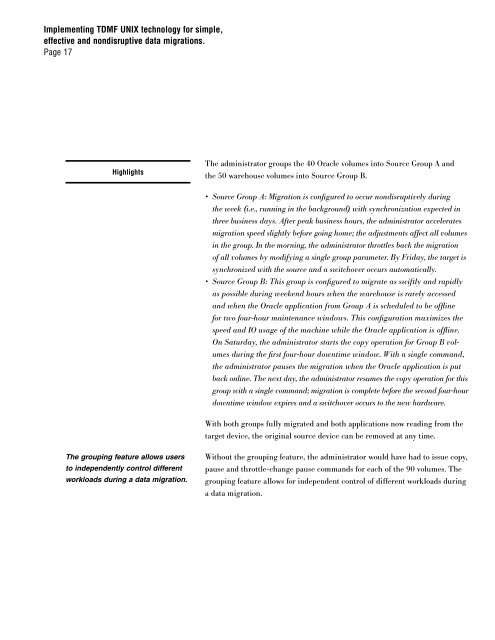Implementing TDMF UNIX technology for simple, effective and ... - IBM
Implementing TDMF UNIX technology for simple, effective and ... - IBM
Implementing TDMF UNIX technology for simple, effective and ... - IBM
Create successful ePaper yourself
Turn your PDF publications into a flip-book with our unique Google optimized e-Paper software.
<strong>Implementing</strong> <strong>TDMF</strong> <strong>UNIX</strong> <strong>technology</strong> <strong>for</strong> <strong>simple</strong>,<br />
<strong>effective</strong> <strong>and</strong> nondisruptive data migrations.<br />
Page 17<br />
Highlights<br />
The grouping feature allows users<br />
to independently control different<br />
workloads during a data migration.<br />
The administrator groups the 40 Oracle volumes into Source Group A <strong>and</strong><br />
the 50 warehouse volumes into Source Group B.<br />
• Source Group A: Migration is configured to occur nondisruptively during<br />
the week (i.e., running in the background) with synchronization expected in<br />
three business days. After peak business hours, the administrator accelerates<br />
migration speed slightly be<strong>for</strong>e going home; the adjustments affect all volumes<br />
in the group. In the morning, the administrator throttles back the migration<br />
of all volumes by modifying a single group parameter. By Friday, the target is<br />
synchronized with the source <strong>and</strong> a switchover occurs automatically.<br />
• Source Group B: This group is configured to migrate as swiftly <strong>and</strong> rapidly<br />
as possible during weekend hours when the warehouse is rarely accessed<br />
<strong>and</strong> when the Oracle application from Group A is scheduled to be offline<br />
<strong>for</strong> two four-hour maintenance windows. This configuration maximizes the<br />
speed <strong>and</strong> IO usage of the machine while the Oracle application is offline.<br />
On Saturday, the administrator starts the copy operation <strong>for</strong> Group B vol-<br />
umes during the first four-hour downtime window. With a single comm<strong>and</strong>,<br />
the administrator pauses the migration when the Oracle application is put<br />
back online. The next day, the administrator resumes the copy operation <strong>for</strong> this<br />
group with a single comm<strong>and</strong>; migration is complete be<strong>for</strong>e the second four-hour<br />
downtime window expires <strong>and</strong> a switchover occurs to the new hardware.<br />
With both groups fully migrated <strong>and</strong> both applications now reading from the<br />
target device, the original source device can be removed at any time.<br />
Without the grouping feature, the administrator would have had to issue copy,<br />
pause <strong>and</strong> throttle-change pause comm<strong>and</strong>s <strong>for</strong> each of the 90 volumes. The<br />
grouping feature allows <strong>for</strong> independent control of different workloads during<br />
a data migration.
















